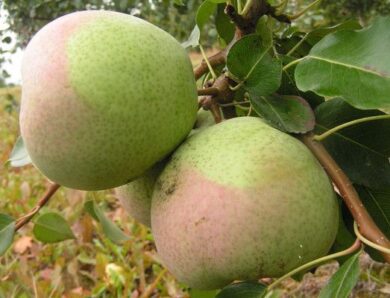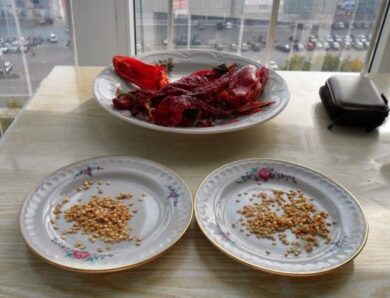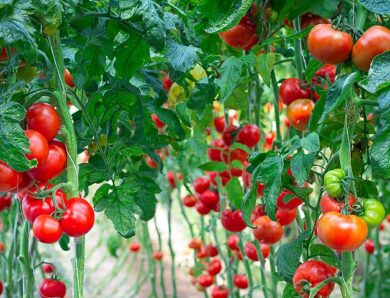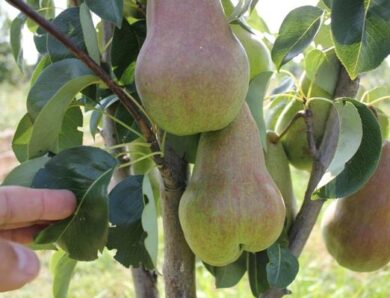Wallpaper for raspberries: making your own hands
The use of intensive technologies today is focused on growing raspberries on the wallpaper. This simple design is very useful for the plants themselves and increases the yield of berry crops. Wallpaper for raspberries is installed immediately after the formation of the bed, so that the shoots first go up and do not bend under the weight of ripening berries. You will learn from this article, how to make a wallpaper yourself, and the need for such a support for raspberries.
Appointment
Modern, especially remontant varieties of raspberries, usually, have high (to 1,8 m), sometimes flexible shoots with fairly long fruit twigs. And because all gardeners prefer to grow large-fruited varieties, giving, in addition, several harvests during the season, then raspberry bushes simply can not withstand the load - they bend, and sometimes break.
To avoid crop loss and maintain a healthy appearance of the bushes, it is recommended to tie raspberries to wallpaper and better, if it is a quality workmanship, not a simple wooden peg. Of course, not all gardeners have enough time, and sometimes desire, produce, and then install wallpaper for raspberries. However, it should be understood, only low-growing bushes with a small number of berries or single bushes can be tied to a peg. But high remontant varieties need a good wallpaper, otherwise under the influence of wind and weight of berries shoots will lie down, and the harvest will simply be lost.
Wallpaper should be installed immediately after planting, and it is better to plant young bushes at once under a wall-paper at distance 50 cm from the structure. This option is considered the most acceptable, as then the bushes will grow and it will be more difficult to establish resistance. If raspberries are planted in the fall, then the bushes, usually, already circumcised, and it is not necessary to tie them - it is better to postpone this event to spring, when lateral shoots appear. Further tying of the bushes is carried out as the branches grow throughout the season.
Video "Best views"
In the video you will learn about the best types of wallpaper.
Advantage of use
Growing raspberries on a support wall-paper is a very convenient agrotechnical reception with a number of advantages both for the gardener., and for plants:
- uniform lighting of shrubs and, as a result, mass ripening of berries;
- due to the large amount of sun the berries are sweeter and juicier;
- good wind blowing, which prevents stagnation of moisture and the development of fungal diseases;
- fixed shoots do not bend from the rain, strong winds and other weather troubles;
- the branches of the lower tier do not come into contact with the ground, thanks to which the berries always remain dry and clean;
- for raspberries, growing on the wallpaper, more convenient to care for: water, feed up, to carry out pruning.
- well-made wallpaper support for raspberries can be used for several years, and if necessary it can be dismantled, or move to another location.
Design options
It would seem, what can be special in the wallpaper - support columns, several rows of wire are attached to them. That's all. However, wallpaper designs, in particular, for tying raspberries, there are quite a variety of forms, species, as well as subspecies. Gardeners divide all types of wallpaper into two main groups:
- single-band, consisting of one surface, and are intended for fixing of stalks;
- and two-lane - more advanced designs, that allow not only to support, but also to form bushes.
Each of these groups, in turn, is divided into several types, depending on the method of tying and the location of the shoots. Single-cavity are divided into the following methods:
- vertical flat - the most common type of construction, on which the plants are located strictly in an upright position;
- free - each shoot is fixed to such constructions separately;
- fan - stems on this structure are arranged in a fan order, which is very convenient for remontant varieties with long and flexible shoots;
- horizontal (this type of construction is used to prepare raspberries for winter) - used to fix the shoots inclined to the ground when sheltered for the winter.
It is worth noting, that outwardly these types of structures are almost indistinguishable. They all consist of poles with fixed rows of wire, and the only difference is in the way the plants are tied up. Single-lane constructions are convenient for growing a small amount of raspberries in private gardens, but when cultivating shrubs on a large scale for commercial purposes, it is better to use two-strip wallpaper, which are shared:
- T-shaped. As the name implies, the structure consists of pipes (beams, fittings), located with the letter "T", and along the edges of the upper bars stretch the wire. The stems are located on different sides, so that there is room in the middle for young growth.
- Y-shaped. This is a more modern option, which provides for the attachment of the upper parts on the hinges, thanks to which you can change the angle of the wallpaper, make it higher or lower.
- V-shaped. This is a wallpaper, in which both planes are inclined downwards. Stems are also formed on two sides, however, it should be taken into account, that the distance between the upper wires should not exceed 2 m.
- Tents. These are rather bulky constructions, which are used mainly on farms, where machine harvesting of berries is practiced.
Two-band wallpaper is more functional, since in addition to fixing the shoots, they control the growth of raspberries: do not allow to thicken, to grow outside the allocated territory, which has a positive effect on the condition of the bushes.
How to do it yourself
Any wallpaper design consists of a frame and several rows of wire, in accordance, to build and mount wallpaper yourself is not so difficult. The work will require any material for support (wooden columns, thin pipes, remnants of fittings), wire (can be replaced by a reinforced rope) and shovel.
Making the simplest wallpaper with a vertical plane consists of the following stages:
- first you need to decide, at what distance the bearing columns will be located, and mark the area;
- if wooden poles or beams are used, then the lower part should be treated with a solution, which prevents spoilage and rot of the material;
- then you can start installation: dig pits about deep 40-50 cm, insert columns, cover with earth and compact well;
- then several rows of wire are stretched, the edges of which are fixed on the columns: the first row should be placed on the level 50 see above the ground, the second - through 30 cm, the third and subsequent - at its discretion, taking into account the varietal characteristics of raspberries.
Other types of wallpaper are made by a similar technology.
In general, there is nothing complicated in the manufacture and installation of wallpaper for raspberries, and thanks to such support it will be possible not only to save, but also to increase the harvest of your favorite berries.
Video "Making your own"
You will learn from the video, how to make your own wallpaper.




